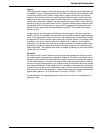
49
General pH Information
Integral
The integral value is used to reduce the steady state error, between the process value and
the setpoint, to zero. For example, assume a process can be manually controlled at a level
of pH 8.0 by sending a 35% control output level to a reagent pump. Now, say that the
system is set up for the controller to provide proportional only control, with the controller
setpoint set to pH 8.0 and the proportional band set to pH 1.0. Note that the nearer the
process gets to the pH 8.0 setpoint, the lower the control output level is. In fact, when the
process is at pH 8.0, the output level will be 0%. Since the process requires that the pump
be operated at 35% for the process to reach pH 8.0, its apparent that proportional-only
control will never quite reach the desired setpoint of pH 8.0. This is where the integral
control comes in.
Integral control can be thought of as adding up the output action from the proportional
control over time. For example, the proportional control output reaches a steady state level
of 5%. If the integral time is set to five minutes, the integral action of the controller will add
an additional 5% to the controller output level over a 5-minute interval. The integral action
is additive, so for every 5-minute interval an additional 5% is added to the controller's
output level. This will allow the controller to bring the process to the desired setpoint level.
Note that the longer the integral time setting, the longer it takes for the integral action to
affect the process. The integral control action is disabled by setting it to zero. Note that the
integral time is in minutes.
Derivative
Derivative control is used to adjust the control output level based upon the rate at which
the process value is approaching or passing the setpoint. Derivative control action would
be used in cases where the process value can rapidly ramp up and overshoot the setpoint.
The derivative setting is in minutes. The output action of the derivative control is equal to
the rate of change of the process (in pH units per minute) times the derivative time, divided
by the proportional band, times negative one. For example, if the process pH is changing
at a rate of pH 0.20 per minute, the derivative time is set to 3.0 minutes, the proportional
band is set to pH 0.80, and the action is “direct” the derivative control output action will be
approximately equal to: (–0.20 pH/minute X 3.0 minute) /0.80 pH = –75%.
During calibration, the analog outputs can remain active, be held, or be transferred to a
preset mA value.


















